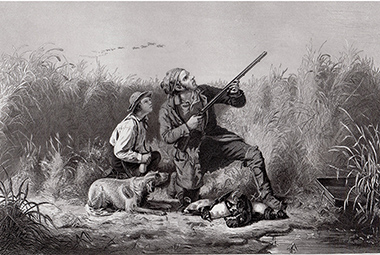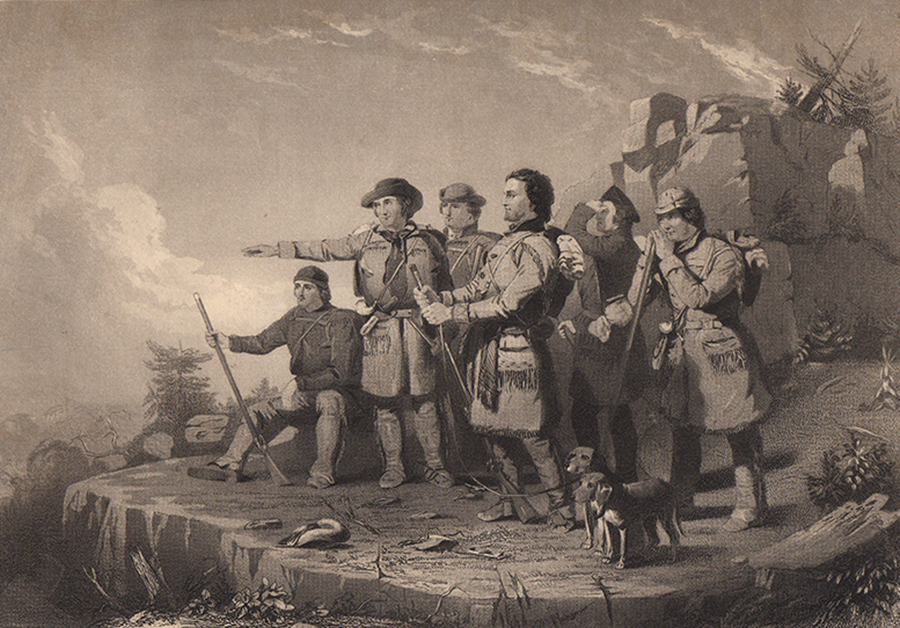William Tylee Ranney (1813-1857)

On the Wing
etching
1852
Painted by Ranney (l.l. margin)
Etched by Burt (l.r. margin)
5 x 7 3/8 inches (image)
9 x 12 inches (paper)
excellent condition
$250

Boone's First View of Kentucky
etching
1850
Painted by W. Ranney (l.l. margin)
Etched by Alfred Jones (l.r. margin)
5 1/2 x 7 7/8 inches (image)
8 1/2 x 11 inches (paper)
Archivally matted.
SOLD
On the Wing is an etching of the William Tylee Ranney painting, an icon of American sporting art. The American Art-Union published its print of the painting in 1850, then in 1852 D. Appleton & Co. bought the plate and published its edition in the book Ornaments of Memory; Or, Beauties of History, Romance, and Poetry: With Eighteen Engravings, from Original Design. “Among the embellishments,” Appleton writes, “we have great pleasure in presenting the reader with specimens of the painter's and engraver's art, which may challenge comparison with any which have ever been executed.”
The etcher, Charles Burt (1823-1892), was a Scottish immigrant who is known for his work with the American Art-Union and the U.S. Treasury Department. He etched another Ranney, Marion Crossing the Pedee, and William Sidney Mount’s Bargaining for a Horse, among others. His engraved portrait of Abraham Lincoln was on the $5 bill until 2000.
The Art-Union was founded to promote American art, to support our artists and to develop an audience for their art. An AAU membership cost $5 a year and brought the subscriber an engraving of a contemporary painting in the AAU collection. The New-York Historical Society guide to its Art-Union collection notes that “most of the artwork purchased and engraved for distribution by the AAU was historical in subject, as was the fashion of the day.” A number of the prints, such as that of George Caleb Bingham’s painting The Jolly Flat Boat Men, have become highly collectible in their own right as examples of exquisite printmaking.
---
In 1850 the American Art-Union displayed Ranney’s painting of Daniel Boone's First View of Kentucky in its New York City gallery. As was the AAU’s wont, an etched version of the painting was published, and it served as the frontispiece of the May 1850 Bulletin of the American Art Union.
Boone himself would remark on his “first view” in his 1784 autobiography: “It was on the first of May, in the year 1769, that I resigned my domestic happiness for a time and left my family and peaceable habitation on the Yadkin River, in North Carolina, to wander through the wilderness of America in quest of the country of Kentucke. … On the seventh day of June … from the top of an eminence, we saw with pleasure the beautiful level of Kentucke.”
The etcher, Alfred Jones (1819-1900), was born in England and came to the United States in the first half of the 19th century. In 1839 he was in New York City studying at the National Academy of Design; he became an academician in 1851. By the end of the Civil War, he was the president of the United States Bank Note Co. of New York.
The artist, Ranney, was known for his history paintings and his love of scenes from the South and West. He was born in Connecticut, raised in North Carolina and worked in New York. It is interesting to note that two years after the Art-Union exhibited Boone’s First View, Ranney produced Squire Boone Crossing the Mountains with Stores for his Brother Daniel, Encamped in the Wilds of Kentucky. And it is also interesting to note that Ranney painted a view of Daniel Boone leading settlers through the Cumberland Gap, Boone’s Party, that resides at the Duncan Tavern Historic Center in Paris, Kentucky. Bingham produced a similar scene in 1850-1851.